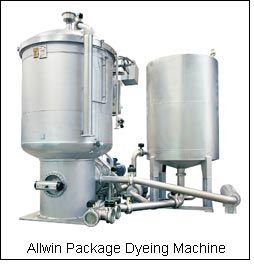Interviews
Save water when dyeing with Fongs technology
17 Mar '10
11 min read

Allwin Package Dyeing Machine
Besides the reduced filling quantity it also optimises the usage of the water. Between guide roller and fabric a hydrostatic pressure is created which increases the crossflow through the fabric and increases thus the washing efficiency. In the Sintensa compartments for knitted fabrics where the fabric is carried through the compartment, this crossflow is created by mechanical means. A driven rotor with a special surface shape pushes the washing liquor through the fabric.
Another important feature to save water is the consequent counterflow inside the washing compartments. Through meandering cascades it is made sure that no dead zones exist and no accumulation of impurities or concentration differences occur. Depending on the dyeing process this counterflow is also applied between different compartments.
With the consequent reduction of process water the side effects are obvious: Less energy is needed to heat the process water which in a dyeing range requires up to 98°C. Thus costly energy is saved at the same time, but also less water to the drain means less treatment costs for the effluents.
Huge potentials for savings exist nowadays in the continuous finishing of knits, which is not so common yet. Goller is supporting especially these customers with technological and technical support to achieve the potential savings for the benefit of the customers but last not least for the environment.
4. Reduce Discharge from the Start till the End – Fong's Water Technology's Water Reuse System:
Despite all the innovative ecological dyeing systems being provided, water consumption in dyeing process is still large. It would be best to treat discharge can then be used back into the dyeing process, lowers new fresh water intake and the discharge volume.
Since the water used in textile manufacturing must be non-staining, water to be reused must be low in turbidity, colour, iron, and manganese. Hardness may cause curds to deposit on textiles and causes problems in processes that use soap. As such water to be reused must first go through a desalination process that reduces its hardness and impurities. Reverse osmosis, an advanced treatment process materialised through modern-day membrane technology, is most commonly used in water reuse to physically remove salt and impurities from wastewater.
Water Reuse systems provided by Fong's Water Technology has unique characteristics and advantages in water impurities removal. Membranes, used with the combination of other traditional filtering processes, can efficiently retain microscopic elements, and lowers the content of organic materials, colour, water hardness and other undesirable substances in wastewater.
As the membrane technology matures, cost of membrane element has decreased while the performance of such increased. Treated water can readily be reused in production, reducing water costs, discharge costs, hence reducing operating costs.
Another important feature to save water is the consequent counterflow inside the washing compartments. Through meandering cascades it is made sure that no dead zones exist and no accumulation of impurities or concentration differences occur. Depending on the dyeing process this counterflow is also applied between different compartments.
With the consequent reduction of process water the side effects are obvious: Less energy is needed to heat the process water which in a dyeing range requires up to 98°C. Thus costly energy is saved at the same time, but also less water to the drain means less treatment costs for the effluents.
Huge potentials for savings exist nowadays in the continuous finishing of knits, which is not so common yet. Goller is supporting especially these customers with technological and technical support to achieve the potential savings for the benefit of the customers but last not least for the environment.
4. Reduce Discharge from the Start till the End – Fong's Water Technology's Water Reuse System:
Despite all the innovative ecological dyeing systems being provided, water consumption in dyeing process is still large. It would be best to treat discharge can then be used back into the dyeing process, lowers new fresh water intake and the discharge volume.
Since the water used in textile manufacturing must be non-staining, water to be reused must be low in turbidity, colour, iron, and manganese. Hardness may cause curds to deposit on textiles and causes problems in processes that use soap. As such water to be reused must first go through a desalination process that reduces its hardness and impurities. Reverse osmosis, an advanced treatment process materialised through modern-day membrane technology, is most commonly used in water reuse to physically remove salt and impurities from wastewater.
Water Reuse systems provided by Fong's Water Technology has unique characteristics and advantages in water impurities removal. Membranes, used with the combination of other traditional filtering processes, can efficiently retain microscopic elements, and lowers the content of organic materials, colour, water hardness and other undesirable substances in wastewater.
As the membrane technology matures, cost of membrane element has decreased while the performance of such increased. Treated water can readily be reused in production, reducing water costs, discharge costs, hence reducing operating costs.
Popular News
Leave your Comments
Folker Stachetzki
Brother Internationale Industriemaschinen GmbH
Therese Premler-Andersson
Textile Machinery Association of Sweden (TMAS)
































-Ltd..jpg?tr=w-120,h-60,c-at_max,cm-pad_resize,bg-ffffff)





.jpg?tr=w-120,h-60,c-at_max,cm-pad_resize,bg-ffffff)
.jpg?tr=w-120,h-60,c-at_max,cm-pad_resize,bg-ffffff)






